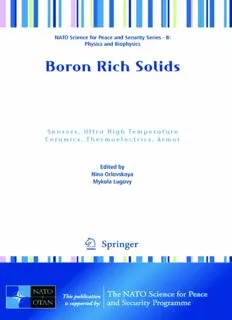
Boron Rich Solids: Sensors, Ultra High Temperature Ceramics, Thermoelectrics, Armor (NATO Science for Peace and Security Series B: Physics and Biophysics) PDF
Preview Boron Rich Solids: Sensors, Ultra High Temperature Ceramics, Thermoelectrics, Armor (NATO Science for Peace and Security Series B: Physics and Biophysics)
Boron Rich Solids NATO Science for Peace and Security Series This Series presents the results of scientific meetings supported under the NATO Programme: Science for Peace and Security (SPS). The NATO SPS Programme supports meetings in the following Key Priority areas: (1) Defence Against Terrorism; (2) Countering other Threats to Security and (3) NATO, Partner and Mediterranean Dialogue Country Priorities. The types of meeting supported are generally "Advanced Study Institutes" and "Advanced Research Workshops". The NATO SPS Series collects together the results of these meetings. The meetings are co- organized by scientists from NATO countries and scientists from NATO's "Partner" or "Mediterranean Dialogue" countries. The observations and recommendations made at the meetings, as well as the contents of the volumes in the Series, reflect those of parti- cipants and contributors only; they should not necessarily be regarded as reflecting NATO views or policy. Advanced Study Institutes (ASI) are high-level tutorial courses intended to convey the latest developments in a subject to an advanced-level audience Advanced Research Workshops (ARW) are expert meetings where an intense but informal exchange of views at the frontiers of a subject aims at identifying directions for future action Following a transformation of the programme in 2006 the Series has been re-named and re-organised. Recent volumes on topics not related to security, which result from meetings supported under the programme earlier, may be found in the NATO Science Series. The Series is published by IOS Press, Amsterdam, and Springer, Dordrecht, in conjunction with the NATO Public Diplomacy Division. Sub-Series A. Chemistry and Biology Springer B. Physics and Biophysics Springer C. Environmental Security Springer D. Information and Communication Security IOS Press E. Human and Societal Dynamics IOS Press http://www.nato.int/science http://www.springer.com http://www.iospress.nl Series B: Physics and Biophysics Boron Rich Solids Sensors, Ultra High Temperature Ceramics, Thermoelectrics, Armor edited by Nina Orlovskaya Department of Mechanical, Materials, and Aerospace Engineering University of Central Florida Orlando, U.S.A. and Mykola Lugovy Institute for Problems of Materials Science Kyiv, Ukraine Published in cooperation with NATO Public Diplomacy Division Proceedings of the NATO Advanced Research Workshop on Boron Rich Solids: Sensors for Biological and Chemical Detection, Ultra High Temperature Ceramics, Thermoelectrics, Armor Orlando, Florida, USA 14-18 December 2009 Library of Congress Control Number: 2010936469 ISBN 978-90-481-9823-8 (PB) ISBN 978-90-481-9817-7 (HB) ISBN 978-90-481-9818-4 (e-book) Published by Springer, P.O. Box 17, 3300 AA Dordrecht, The Netherlands. www.springer.com Printed on acid-free paper All Rights Reserved © Springer Science + Business Media B.V. 2011 No part of this work may be reproduced, stored in a retrieval system, or transmitted in any form or by any means, electronic, mechanical, photocopying, microfilming, recording or otherwise, without written permission from the Publisher, with the exception of any material supplied specifically for the purpose of being entered and executed on a computer system, for exclusive use by the purchaser of the work. CONTENTS Contributing Authors................................................................................ix Preface........................................................................................................xv Acknowledgment.....................................................................................xvii Boron Carbide/Boron Carbide-Carbon Nanofibers Laminates with Weak Interfaces.............................................................................................1 N. Orlovskaya, M. Lugovy, V. Slyunyayev, V. Subbotin, F. Liang, J. Gou, J. Kuebler and T. Graule All Ceramic Cantilever Sensors with Boron Carbide Layer: Advantages and Dimensional Limitations......................................................................13 M. Lugovy Raman Effect in Boron and Boron-Rich Compounds.................................29 H. Werheit and V. Filipov Experimentally Founded Charge Transport Model for Icosahedral Boron-Rich Solids.......................................................................................45 H. Werheit Magnetic and Thermoelectric Properties of Boron-Rich Solids.................63 T. Mori Scratch Studies in Boron-Rich Lightweight and Ultrahigh Temperature Ceramic..................................................................................83 D. Ghosh and G. Subhash The Electronic Properties of Metal Borides and Borocarbides: Differences and Similarities .......................................................................95 S. Lassoued, R. Gautier and J.-F. Halet Investigation of Hard Boron Rich Solids: Osmium Diboride and -Rhombohedral Boron......................................................................115 M. Hebbache and D. Živković v vi CONTENTS Elastic and Vibration Properties of Boron–Carbon Ultra Hard Materials....................................................................................................131 J. E. Lowther Processing and Properties of Ultra-Refractory Composites Based on Zr- and Hf-Borides: State of the Art and Perspectives.........................147 A. Bellosi, S. Guicciardi, V. Medri, F. Monteverde, D. Sciti and L. Silvestroni Behavior of Boron Doped Graphites and Boron Carbide under Ion Beam and Plasma Irradiation....................................................................161 L.B. Begrambekov, O.I. Buzhinsky and A. Zakharov Vibrational Spectroscopy of Adsorbates on the (111) and (100) Surfaces of Lanthanum Hexaboride.........................................................................181 T. Yorisaki, A. Tillekaratne, YU. Moriya, C. Oshima, S. Otani, and M. Trenary Zirconium Dodecaboride, a Novel Superconducting Material with Enhanced Surface Characteristics.....................................................195 M. Belogolovskii, I. Felner and V. Shaternik Boron under Pressure: Phase Diagram and Novel High-Pressure Phase..207 A. R. Oganov Behavior of the Crystalline Boroncarbide Coating under Tokamak Conditions.................................................................................................227 O.I. Buzhinskij and V.G. Otroshchenko Electron Structure, Transport, and Superconducting Properties of ZrB , ZrB , YB and MgB ..................................................................237 12 2 6 2 V.A. Gasparov Densification, Microstructure Evolution and Mechanical Properties of Ultrafine SiC Particle-Dispersed ZrB Matrix Composites..................261 2 F. Monteverde, S. Guicciardi, C. Melandri and D.D. Fabbriche Mechanochemically Driven Syntheses of Boride Nanomaterials.............273 R.G. Blair CONTENTS vii Vibrational Properties of Zr(Hf)B –SiC UHTC Composites 2 by Micro-Raman Spectroscopy.................................................................287 M. Donohue, C. Carpenter and N. Orlovskaya Synthesis and Sintering Strategies of Boron-Rich Solids.........................303 L. Sartinska Field-assisted Densification of Superhard B O Materials with 6 Y O /Al O Addition.................................................................................319 2 3 2 3 M. Herrmann, J. Raethel, K. Sempf, M. Thiele, A. Bales and I. Sigalas Index.........................................................................................................327
Description: